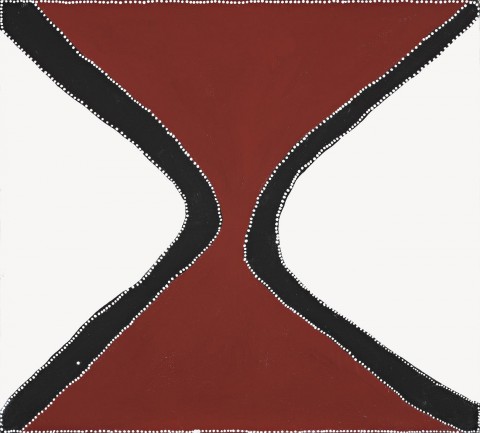JIRLJIN (RED POCKET), 2000
PADDY NYUNKUNY BEDFORD
ochres and pigments with acrylic binder on Belgian linen
122.0 x 135.0 cm
signed with initials verso: PB
bears inscription verso: To: Chapman Gallery, Jirrawun Arts cat. PB 3 2000.77
Jirrawun Arts, Kununurra
Chapman Gallery, Canberra
Private collection, Sydney
Storer, R., Paddy Bedford, Museum of Contemporary Art, Sydney, 2006, p. 148 (illus.)
This work is accompanied by a certificate of authenticity from Jirrawun Arts, Kununurra
The paintings of Paddy Bedford mostly refer to existing places in the landscape of the country he grew up in which were integral to his everyday life. Roads and rivers are recurring motifs in his work and other amorphous features evoke the vertical escarpments, rounded hills and large rocks of the Kimberley. At the same time, the subject matter of his paintings is drawn from two primary and very different sources of knowledge and experience: historical events and the more mundane stories about daily life on cattle stations in the Kimberley intersecting with a profound and lyrical knowledge of the land and its creation stories.
This painting shows a place, called Jirljin in Gija and Red Pocket in English, which is adjacent to the Springvale-Landsdown Road, between Ida Mere Yard and Janterrji, south east of Bedford Downs Station. Here there is a pocket of ‘red’ earth surrounded by hills in an area that is typically characterised by black soil plains running all the way to the base of the Durack Ranges at the edge of the East Kimberley plateau. It is part of Bedford’s uncle’s country and there are a lot of small caves in the area that were traditional Gija camping places. In the neighbouring hills the country is called Langanban, a dreaming place for a round fungus known as langany.1
Jirljin (Red Pocket), depicts two big hills separated by a narrow gap through which people passed either on foot when walking though country or on horses when mustering cattle. The artist used to ride through this country when, as a young man, he worked as stockman. The ochre palette highlights Bedford's link to the more familiar style of the earlier east Kimberley painters Rover Thomas and Paddy Tjamatji, but the large dominant forms along with the interplay between positive and negative space signal the original vision of an artist who created his own representations of country, a harbinger of what was to come.
The importance of painting for Paddy Bedford was multi-layered – in addition to passing on knowledge about his country, it’s features, and the sacred narratives connected to it,2 painting was an expression of country and cultural memory. Bedford’s art was also a claim to identity and consequently his paintings are an assertion of an intimate connection to the land itself. As Michael Dolk argues, his painting suggests a physical and tactile relation to land, 'To behold painting is to hold country and to remain beholden to its ancestral tradition’.3
1. Information from accompanying Jirrawun Arts certificate of authenticity
2. Petitjean, G., ‘Crossing Frontiers: Paddy Bedford in Europe’, AAMU, Museum of Contemporary Aboriginal Art, Utrecht, 2009
3. Dolk, M., 'Are we Strangers in this Place', in Storer, R., Paddy Bedford, Museum of Contemporary Art, Sydney, 2006, p. 20
CRISPIN GUTTERIDGE
